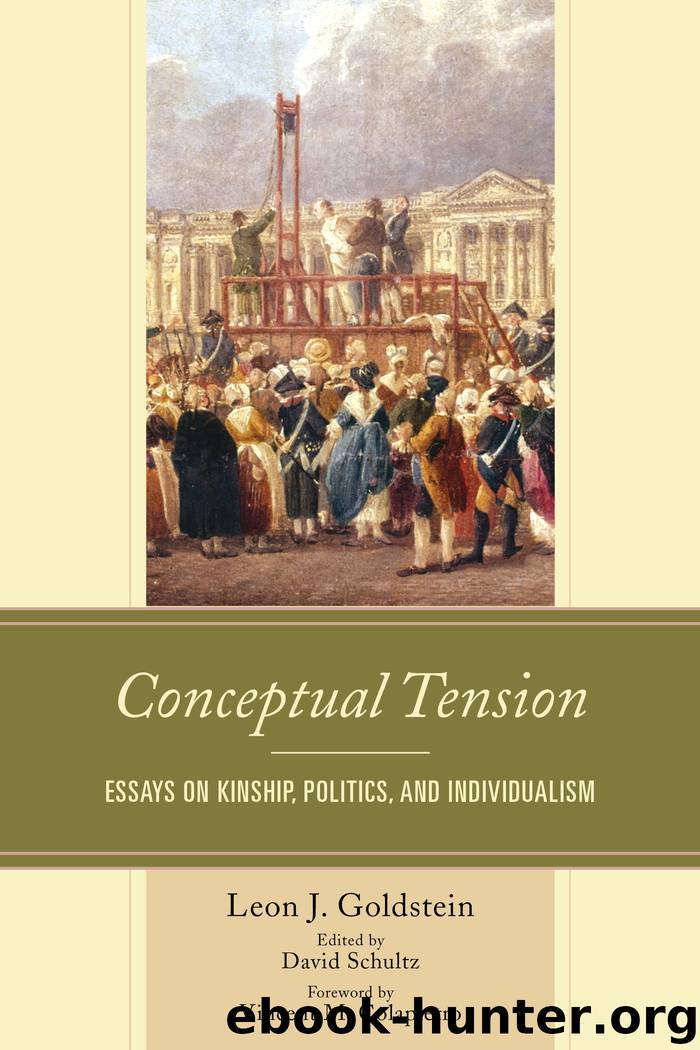Conceptual Tension by Schultz David Colapietro Vincent M. Goldstein Leon J

Author:Schultz, David, Colapietro, Vincent M., Goldstein, Leon J.
Language: eng
Format: epub
Tags: undefined
Publisher: Lexington Books
Published: 2012-03-15T00:00:00+00:00
Spiro then goes on to say that for this kind of analysis the crucial problem is the identification of significant features: “For componential analysts, the attributes of kinsmen that constitute their significant feature for their classification are the ‘inherent distinctions’ of kintypes—sex, relative age, generation, lineality, and the like—which they conceive to be the ‘properties of genealogical space.’”[99] After discussing some examples, Spiro then asserts: “To the best of my knowledge, no native speaker has been found anywhere who defined his kinterms by means of these criteria—at least not exclusively.”[100]
What Spiro doesn’t like about componential analysis is that it likens kinship to be a domain which is independent of the actual psychological give-and-take of real human interrelationships. It is clear from what he says—as well as from what he does when he describes the sphere of kinship in the course of his ethnographic presentation—that in Spiro’s view we cannot expect to understand the sphere of kinship by attending namely—much less solely—to terms and their meanings in genealogical space. We know that there are societies which do not distinguish terminologically between mother and mother’s sister, and about that Spiro says that “to contend that because the kintypes ‘mother’ and ‘mother’s sister’ are not denoted by separate terms, they have no separate cognitive meanings, reveals the limitations of a theory that confines cognitive meaning to semantic—and specifically, referential—meaning, and assumes that objects have no conceptual status unless they are named.”[101] Spiro immediately adds that if we attend less to kinterms—and more to behavior—it can be shown that since conceptions of kinsmen are, to a large extent, acquired in the process of interaction with them, children’s “conceptions of kin are often acquired prior to their acquisition of kinterms,” and he goes on to add that they may acquire the terminology with reference to him whose exact genealogical relationship to them they don’t even know. If behavioral variability is solvent to those questions of conception, concepts are rather more open textured than we would expect on the assumptions of componential analysis.
Spiro’s approach to the determination of what kinship means is “six pronged.”[102] This suggests that kinship is to be understood as the outcome of the interaction of a number of elements which enter into and emerge from the experiences of the individuals who constitute the society. Given the variability which all this invokes, one must suppose that what kinship means cannot be some explicit state of conditions for the application of a set of terms to a collection of relatives. Without presenting the details of Spiro’s ethnography of the Burmese people he selected, one can see readily enough that if his practice does in fact accord with his program—readers will have to decide that for themselves—we have, once again, the expectation of an account of kinship as open textured.
Early in his study of Malay kinship, David Banks tells us that the Malays make use of the ideas of closeness and distance in composing relationships, and likewise the distance between heavy and light. The first
Download
This site does not store any files on its server. We only index and link to content provided by other sites. Please contact the content providers to delete copyright contents if any and email us, we'll remove relevant links or contents immediately.
The remains of the day by Kazuo Ishiguro(8349)
Tools of Titans by Timothy Ferriss(7758)
Giovanni's Room by James Baldwin(6770)
The Black Swan by Nassim Nicholas Taleb(6732)
Inner Engineering: A Yogi's Guide to Joy by Sadhguru(6418)
The Way of Zen by Alan W. Watts(6264)
Asking the Right Questions: A Guide to Critical Thinking by M. Neil Browne & Stuart M. Keeley(5328)
The Power of Now: A Guide to Spiritual Enlightenment by Eckhart Tolle(5307)
The Six Wives Of Henry VIII (WOMEN IN HISTORY) by Fraser Antonia(5206)
Astrophysics for People in a Hurry by Neil DeGrasse Tyson(4981)
12 Rules for Life by Jordan B. Peterson(4150)
Housekeeping by Marilynne Robinson(4036)
The Ethical Slut by Janet W. Hardy(4018)
Skin in the Game by Nassim Nicholas Taleb(3951)
Double Down (Diary of a Wimpy Kid Book 11) by Jeff Kinney(3889)
Ikigai by Héctor García & Francesc Miralles(3846)
The Art of Happiness by The Dalai Lama(3828)
Skin in the Game: Hidden Asymmetries in Daily Life by Nassim Nicholas Taleb(3707)
Walking by Henry David Thoreau(3667)
